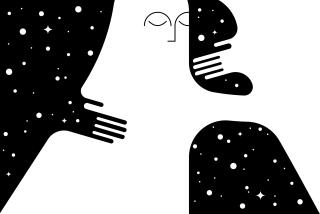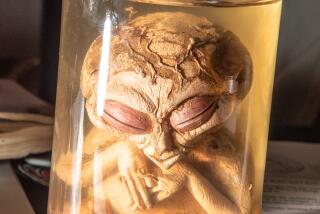A new ‘Library of Esoterica’ brings the occult to your coffee table
Not so long ago, the discovery of esoteric knowledge was a rite unto itself, requiring research and travel, as many dead ends as discoveries. Today, these quests are as simple as a Google search, a glance at an astrology app or a scroll through Instagram, where the hashtag #witchesofinstagram will lead you to nearly 6 million posts.
The democratization of the arcane is a welcome development, but the mystery of the occult will never lose its allure. The Library of Esoterica, a new series from the art book publisher Taschen, acts as a bridge between the dark halls of history and the vast data at our fingertips. Created by a team based in Los Angeles, the series debuted in August with “Tarot”; volume two, “Astrology,” just landed in bookstores. “Witchcraft” is slated for September.
Edited by author, journalist and filmmaker Jessica Hundley, the series speaks the universal language of symbolism. “The idea,” says Hundley, “was to create a super introductory, very inclusive and seductive way into these practices, which is through the art.” Taschen, with its lavish art production, made the ideal partner “because that’s what they do best.”
When Taschen founder Benedikt Taschen suggested to managing editor Nina Wiener that the topic of “secret knowledge” was worth exploring more deeply, “Jessica was one of the first people I thought of to go to,” says Wiener.
Metaphysics and the counterculture are a through line of Hundley’s work, including a number of Taschen collaborations — most notably an overview of Dennis Hopper’s photography enriched by hours of interviews with the actor.
Hundley has been fascinated by alternative spiritualities and the occult since she was a goth-punk teenager on the East Coast, “listening to Siouxsie Sioux and reading tarot cards.” She moved to Los Angeles in 1998, drawn to the city’s legacy of esoteric exploration and its renown as a place where dreams are made manifest and identity is mutable. “The freedom to define your own identity also means defining your own spirituality,” Hundley says, “and that’s built into so much of the ethos of Los Angeles.”
L.A.’s homegrown institutions helped get the Library off the ground. The Philosophical Research Society in Los Feliz, a library and research center founded in the 1930s by scholar, mystic and collector Manly P. Hall, has been the team’s primary research partner. The Getty, with its collection of alchemical art and texts, was another important local resource. But contributors ranged far and wide, from the Met and the British Museum to artists in Tokyo and Kenya.
For the series’ designer, Nic Taylor, one “formative moment” was a visit to New York City’s Morgan Library, which houses J.P. Morgan’s collection of occult art and books — including the oldest existing tarot cards, the gold-leafed Visconti-Sforza deck from 14th century Italy.
In conceiving an overarching series design, Taylor, co-founder of L.A.-based Thunderwing Studios, incorporated elements common to antiquarian books, aiming to “take the gestures that are historic to bookmaking and update them and make them feel fresh.” Every detail, from the series logo — a key formed by the letters T, L, O, E — to the sacred geometric gold foil designs along the spines, feeds into the reader’s experience of these books as objects of beauty and, yes, magic.
Cards on the Table
“Tarot,” written by Hundley, sets the tone for the series. “I wanted to come at it from a journalistic, academic viewpoint and not get mired in the dogma,” she says. This meant consulting with numerous specialists and quoting foundational texts while still allowing her passion to shine through. The book is organized by card, not chronology, inviting us to consider personal journeys. The first in the 78-card deck is the Fool, “full of blissful ignorance and blind optimism,” Hundley writes, “as he takes his first step into the abyss.”
This archetypal character then encounters different aspects of himself in the form of the High Priestess, the Hermit, the Devil. He meets the world with innocent joy (the Sun) and explores his subconscious (the Moon); he confronts destiny (the Wheel of Fortune), destruction (the Tower) and, finally, liberation (the World). Is it any wonder that artists are consistently drawn to these symbols?
There are about 20 historical examples of each “major arcana” card in “Tarot,” creating a tapestry of interpretations. More than 100 featured decks include work by fine artists such as Salvador Dali, Francesco Clemente, Pedro Friedeberg, Niki de Saint Phalle and Penny Slinger, the feminist-surrealist who wrote the book’s foreword. The best-known deck, from which most modern tarot evolved, is the 1909 Rider-Waite-Smith Tarot, created by Pamela Colman Smith and Arthur Edward Waite, who met in England as members of the Hermetic Order of the Golden Dawn. (“It was essentially an artist collective,” says Hundley of the secret society, which included William Butler Yeats.)
Tarot evolves alongside art and culture, Hundley says: “You had a surge of decks made in the 1960s and ‘70s that were aligned with the counterculture … and then with the New Age movement of the ‘80s you had another surge … I think with each movement, the circle comes back around.”
Every decade hosted brilliant additions to the canon; witness Julia Turk’s Navigators Tarot of the Mystic Sea from 1994, whose vibrant Sun card shines from the cover of the book. But it was the 2012 self-publication of Kim Krans’ Wild Unknown deck, inspired by the natural world, that Hundley points to as the launch of a new era. Working in all media, contemporary artists continue to evolve the form, drawing from a prismatic array of philosophies, traditions and cultural movements — from ecofeminism and shamanism to Mexicayotl and Black Power. (The last one features Billie Holiday and Tina Turner as figures.)
Which brings us to the democracy of the web. Many of these self-published decks were discovered online. Browsing eBay, Hundley happened upon an exquisite deck of Afro-futurist digital collages by the artist Manzel Bowman. Not only are several of Bowman’s cards included in “Tarot,” his art graces the cover of “Astrology.”
The Return of the Stars
Technology also democratized the age-old practice of seeking guidance from the cosmos, as Susan Miller writes in her forward to “Astrology.” One of the first in her field to flourish online (she launched her popular site Astrology Zone in 1995), Miller describes how computer-generated charts have made complicated calculations accessible to a new generation.
“Astrology” focuses on what we know as the Western horoscopic system, codified in 539 BC when the Babylonians created and named the wheel of the zodiac. By charting the movements of five planets plus the sun and moon in relation to this wheel, they gave us a way to talk about our identities, our instincts, how we love and communicate.
Andrea Richards, the book’s author, is the first to say that she is not an astrologer but a journalist and scholar, interested in examining “the beliefs around beliefs.” She dismisses the notion of astrology as “fortune-telling”; instead, it’s about “patterns and stories and the transmissions of stories between generations.”
One revelation of this volume is that astrology and astronomy were once sister sciences. Cambridge University even had an astrology chair. But after the Enlightenment, shame was cast upon matters of the spirit. And yet, as Richards attests, the practice never went away: world leaders from Queen Elizabeth I to Winston Churchill to the Reagans have relied on the counsel of their personal astrologers.
As with “Tarot,” one comes away with an understanding of astrology’s place in history, pop culture, art, mythology and psychology. Included are 15th century frescoes, 18th century etchings, Mucha posters, cigarette ads, assemblage work by Betye Saar in the 1960s, a 1970s psychedelic calendar, ’80s fantasy art, scientific charts and telescopic space photographs. Each chapter is anchored by the words of respected scholars and younger stars like Chani Nicholas and Jessica Lanyadoo.
In Richards’ opinion, we are experiencing a new kind of spiritual awakening, in which intellectual rigor can coexist with the metaphysical. While writing the book, she recalls, “At one point I had this remarkable day. I had spoken with a scientist at NASA, an astrologer and a historian, and I was like, ‘that confluence of people is exactly what this book is.’ … Finally, I think people are ready to recognize that there are multiple paths to truth.”
So it will be for the next book in the series. Author, podcast host and professional witch Pam Grossman, who is co-editing the upcoming “Witchcraft” with Hundley, believes those multiple paths have always been key to witchcraft’s appeal. “There is no pope of witchcraft,” she says. “Everyone’s practice is extremely personal.”
What Grossman finds unique about this cultural moment (in which, for example, witchcraft is exploding on TikTok) is that “more previously marginalized people are in positions to make decisions — queer people, people of color who have a history of being othered by the white cis patriarchy.”
By virtue of this intersection with cultural shifts and the long association of the witch archetype and feminism, “Witchcraft” will likely be more political than the first two volumes — which does not mean it will be any less aesthetically striking. Grossman was a consultant on Zoe Lister-Jones’ recent revamp of “The Craft,” and she is “deeply interested in how cinema, fashion, music and television have helped us to evolve the image of the witch.” She also shares with Hundley a love for fine artists, including Leonora Carrington and Remedios Varo, “who use their art practice as a form of magic making.”
Growing up in the analog era, Grossman spent hours in her local library poring over a series called “Man, Myth & Magic.” She considers the Library of Esoterica to be “an updated, more stylish version of that.” The prospect, Grossman says, “makes the 14-year-old in me levitate with joy.”
Nelson is the editor of Slouching Towards Los Angeles: Living and Writing by Joan Didion’s Light” and the co-author of “Judson: Innovation in Stained Glass.”
More to Read
Sign up for our Book Club newsletter
Get the latest news, events and more from the Los Angeles Times Book Club, and help us get L.A. reading and talking.
You may occasionally receive promotional content from the Los Angeles Times.






